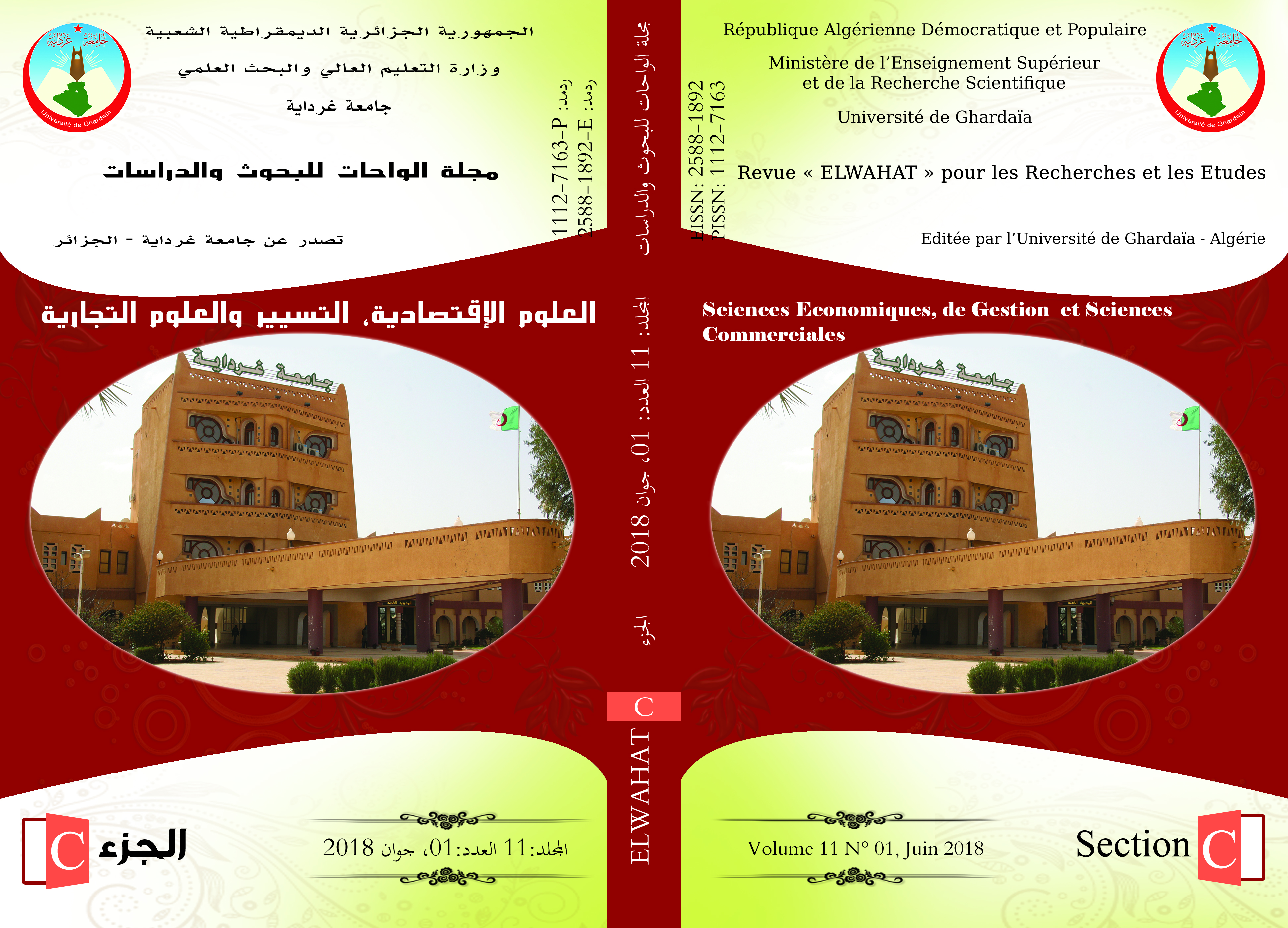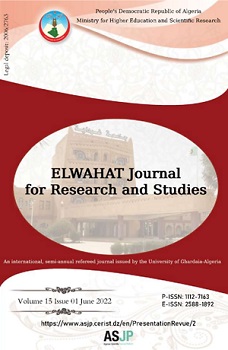Contribution à l’étude de la mésofaune dans le Parc National de Chréa
Abstract
Le présent travail concerne l’étude des peuplements de la mésofaune dans deux habitats forestiers Cedrus atlantica (Station I) et Quercus canariensis (Station II) au niveau du Parc National de Chréa (Algérie). Des deux stations ressortent 1921 individus regroupés dans cinq familles. Dans la station I, 899 individus recueillis représentés par 464 Acarida, il est suivi par un effectif égal à 380 des isotomidae. Par contre le nombre d’individus des Enchytreidae, Diplura et des Scutegelleidae est assez bas, égal à 23, 17 et 15 individus. Dans la station II, 1022 individus sont récoltés reproduis par un 899 acarien, suivis par les isotomidae avec 240 individus et par les Enchytreidae (36); en fin Diplura présente l’effectif le plus bas.
Mots clés : mésofaune, Cedrus atlantica, Quercus canariensis, sol et Parc National de Chréa.
References
ATHIAS-HENRIOT C. et CANCELA DA FONSECA J.P., 1976 - Microarthropodes édaphiques de La Tillaie (Forêt de Fontainebleau). Composition et distribution spatio-temporelle d'un peuplement en placette à litiere de hêtre pure (Acariens et Collemboles). Rev. Ecol. Bol. Sol, 13, 2, 3, 15-329.
ATTAL B., 1995 - Contribution à l'étude de l'entomofaune du Chêne vert (Quercus ilex L.) dans le parc national de Chréa. Thèse Magister, Int. nati. agro., El Harrach, 250 p.
BACHELIER, G. 1978. La faune du sol, son écologie et son action. Ed. Organisation Recherche Scientifique et Technique Outremer (O.R.S.T.O.M), Paris, 391 p.
BAUWT R. et BIEKNAUX J., 1967 - Scutigerelh immaculatu Newport. Rbflexions sur la Biologie et les moyens de lutte. Bull. Rech. &on. Gembloux (Belgique), II, 2, 215-226.
DASH M.C. et CRAGG J.B., 1972 - Ecology of Enchytraeidae (Oligochaeta) in Canadian Rocky Mountain Soils. Pedobiologia, 12, 5, 323-335.
DUCARME X., ANDRÉ HM., WAUTHY G. and LEBRUN P., 2004 - Comparison of endogeic and cave communities: microarthropod density and mite species richness. Eur. J. Soil Biol., 40 : 129 – 138.
FEKKOUN, S. ET GHEZALI, D.J. 2007. L’évolution de l’acarofaune du sol de la région de Boufarik. Journées internationales Zool. Agri. For., 8 - 10 avril 2007, Dép. Zool.Agro. For., Inst. Nati. Agro., El Harrach, p. 189.
FOX 1., 1957- The insect family Japygidae (order Thysanura) in Puerto Rico. J. Agpic. Univ. Puerto- Rico, 41, 35-37.
GHAZALI D., 2012 - systématique et bioécologie des acariens du sol (acari-oribattida) en Algerie. These Doctorat, Inst. Nati. Agro. El Harrach, 135p.
HALIMI A., 1980- l’atlas Blidéen-climat et étages végétaux. Ed. Office des publications nationales, Alger, 523p.
HONCIUC V. and MANU M., 2010 - Ecological study on the edaphic mites populations (Acari: Mesostigmata-Gamasina; Oribatida) in urban areas from Romania. Rom. J. Biol. – Zool., Vol. 55, (1) : 3 – 17.
ILLIG J., NORTON R. A., SCHEU S. and MARAUN M., 2010 - Density and community structure of soil- and bark-dwelling microarthropods along an altitudinal gradient in a tropical montane rainforest. Exp. Appl. Acarol. 52 (1) : 49 – 62.
ElWahat pour les Recherches et les EtudesVol.10 n°1 (2017) : 66-75
Isserhane Warda et Baha Mounia
75
KUHNELT W., 1961 - SoiZ Biology. Faber & Faber éd. (Lond.), 397 p.
LARID D., 1989 - Comparaison faunistique de quelques stations du parc national de Chréa. Thèse Ingénieur, Inst. nati. agro., El Harrach, 188 p
. LAVELLE P., 1988. - Assessing the abundance and role of invertebrate communities in tropical soils: aims and methods. Journal of African Zoology 102: 275-283.
LAVELLE P. & SPAIN A. V., 2001. SoilEcology. Kluwer Scientific Pubications, Amsterdam.
LAVELLE P., DECAËNS T., AUBERT M., BAROT S., BLOUIN M., BUREAU F., MARGERIE P., MORA P. et J.-P. R., 2006. Soilinvertebrates and ecosystem services. European Journal of SoilBiology. 42 S3-S15.
LEGAKIS A., 1994. Community structure and speciesrichness in the Mediterranean-type soilfauna. M. Arianoutsou and R.H. Groves, Plant-animal interactions in Mediterranean-type ecosystems. Chapter 4 Pages 37-45. Kluwer AcademicPublishers. Printed in the Netherlands. Page 38.
LINCOLN R., ROSSHALL G., CLARK P.F., 1982- in Wikram M. (1986) : Soilinhabitingarthropods as indicators of EnvironmentalQuality Acta biologicaHungarica 37(1), pp. 73-84.
MAZARI G., 1995 - Etude faunistique de quelques stations du parc national de Chréa. Thèse Magister sci. agro., Inst. nati. agro., El Harrach, 165 p.
NIELSEN C.O.,1955b - Studies on Enchytraeidae. V - Factors causing seasonal fluctuations in numbers. Oikos, 6, 153-169.
NOTI M.I., ANDRE´ H.M., DUCARME X. and LEBRUN P., 2003 - Diversity of soil oribatid mites (Acari: Oribatida) from High Katanga (Democratic Republic of Congo): a multiscale and multifactor approach. Biodivers Conserv (12) : 767 – 785.
VANNIER G., (1971)- Technique d’étude des populations de microarthropodes du sol. II- exemple d’une étude écologique : les microarthropodes et 1 Btat hydrique du sol. In KLOViedans les sols, Gauthier Villars id. (Paris), 83-109 et 111-146.
WATERHOUSE J.S., 1968 - Studies on the garden §ymphylan, Scutigerella immaculata, Symphyla : Scutigerellidae. Canad. Er2t., 100, 172-178.
WAUTHY G. and LEBRUN P., 1980 – Synecology of forest soil oribatid mites of Belgium. I. The zoological classes. Soil biology as related to land use practices, pp. 795 - 805.
WAUTHY G., 1981 - Synecology of forest soil oribatid mites of BeIgium (Acari, Oribatida) II. - Zoosociological uniformity. Acta Oecologica, Oecol. Gener, 2 : 31 – 47.






